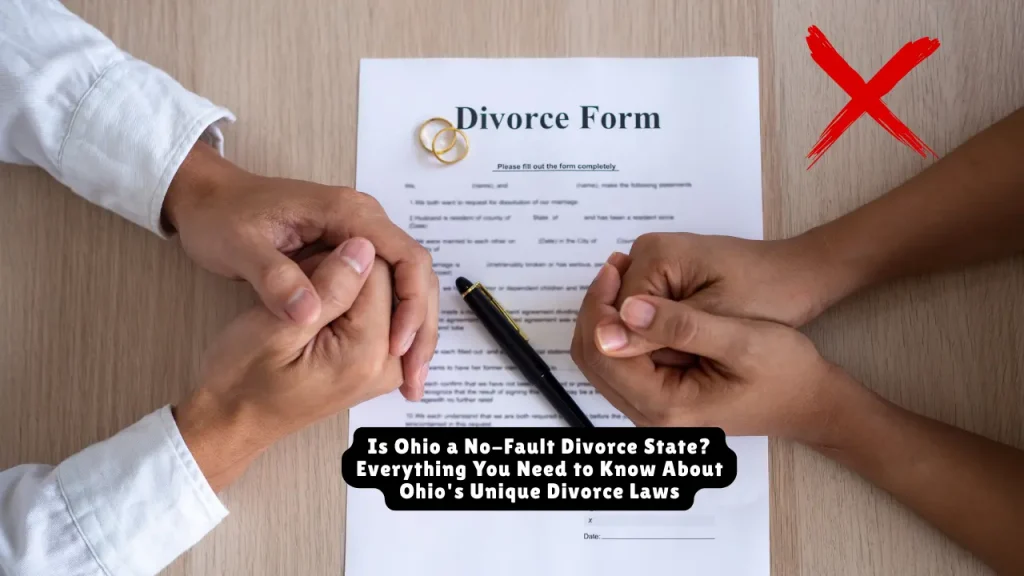Is Ohio a No-Fault Divorce State? Everything You Need to Know About Ohio’s Unique Divorce Laws
Ohio is definitively a no-fault divorce state, meaning you can end your marriage without proving your spouse did anything wrong. Under Ohio law, couples can file for divorce based on “incompatibility,” which requires no fault or wrongdoing on either spouse’s part.
But here’s what makes Ohio unique: Ohio offers three distinct ways to end a marriage—divorce, dissolution, and legal separation—each with different requirements and benefits that could save you thousands of dollars and months of court time.
Understanding these options isn’t just academic—it’s financial. The wrong choice could cost you $15,000 more in legal fees and extend your case by 12-18 months.
Table of Contents
Ohio’s Three Paths to End Your Marriage
Option 1: No-Fault Divorce (Incompatibility)
Most people who file for divorce in Ohio list incompatibility as the reason their marriage is ending. This is Ohio’s primary no-fault ground, and it’s surprisingly straightforward.
Requirements for incompatibility divorce:
- Either spouse must live in Ohio for at least 6 months before filing
- You must genuinely believe the marriage cannot be saved
- No proof of wrongdoing is required
Timeline: 42-120 days (Ohio’s mandatory waiting period is 42 days) Best for: Cases where spouses disagree on terms but want to avoid fault allegations
Option 2: Dissolution of Marriage (Ohio’s Streamlined Option)
Here’s Ohio’s hidden gem: Ohio law refers to a no-fault divorce where parties agree to terms as a “dissolution of marriage”. This isn’t just semantics—it’s a completely different legal process.
Dissolution requirements:
- Both spouses must agree on all terms before filing
- Joint petition filed together (not one suing the other)
- Complete separation agreement prepared in advance
- Both parties appear at final hearing together
Timeline: 30-90 days typically Cost savings: Often 60-70% less expensive than contested divorce
Option 3: Legal Separation
Legal separation does not legally end your marriage but allows couples to live apart with court-approved arrangements for property, support, and children.
When separation makes sense:
- Religious or personal objections to divorce
- Maintaining health insurance benefits
- Social Security or military benefit considerations
- Possibility of reconciliation
Related article: Life360 Lawsuit Updates 2025

Ohio’s Fault-Based Grounds: Still Available But Rarely Used
While Ohio embraces no-fault divorce, Ohio law still allows for fault-based divorce in specific situations. These traditional grounds include:
- Adultery: Proven extramarital affairs
- Extreme cruelty: Physical or mental abuse
- Willful absence: Spouse missing for one year or more
- Gross neglect of duty: Failure to support family
- Habitual drunkenness: Chronic alcohol abuse
- Imprisonment: Spouse incarcerated in penitentiary
Reality check: Less than 15% of Ohio divorces use fault grounds because they’re expensive, time-consuming, and rarely affect property division or custody outcomes.
The Ohio Advantage: Why Dissolution Beats Traditional Divorce
Ohio’s dissolution process offers unique benefits that most states don’t provide:
Speed and Efficiency
Traditional contested divorce in Ohio averages 12-18 months. Dissolution typically resolves in 30-90 days because there’s no discovery process, no depositions, and minimal court time.
Cost Savings
Average Ohio contested divorce: $15,000-$25,000 per spouse Average Ohio dissolution: $2,500-$5,000 total for both spouses
Privacy Protection
Dissolution proceedings involve less public record creation. Unlike divorce, dissolution doesn’t involve the court making decisions about property division, child custody, or support—spouses work out those issues themselves.
Reduced Conflict
Since both parties must agree before filing, dissolution eliminates the adversarial “plaintiff vs. defendant” dynamic that can damage co-parenting relationships.
Related article: Who Is the Plaintiff in a Divorce?
Ohio Residency Requirements: What You Need to Know
For a no-fault dissolution, you can file if either you or your spouse has lived in Ohio for at least six months. But there are important nuances:
Military Exception
Active duty military members stationed in Ohio can file immediately, even without six months of residency.
Out-of-State Spouse
You can file for divorce in Ohio if your spouse lives in another state, provided you meet Ohio’s residency requirement.
Jurisdiction Considerations
If children are involved, Ohio courts need jurisdiction over custody matters, which may require the children to have lived in Ohio for at least six months.
Recent Changes in Ohio Divorce Law (2023-2024)
Simplified Forms and Procedures
The Ohio Supreme Court provides form downloads for Ohio Dissolution without Children and Ohio Dissolution with Children, making self-representation more accessible.
Electronic Filing Expansion
Most Ohio counties now accept electronic filing for dissolution and divorce cases, reducing processing times by 2-3 weeks.
Updated Child Support Guidelines
Ohio’s child support calculations were updated in 2023, affecting both divorce and dissolution cases involving minor children.
Related lawsuit: $8.9 Million Poppi Lawsuit Settlement
Real-World Ohio Divorce Examples
Case Study 1: The Smart Dissolution Choice
Sarah and Mike from Columbus had been married 8 years with two children. Initially considering traditional divorce, they discovered dissolution could save them $18,000 and 10 months of legal proceedings.
Their dissolution included:
- 50/50 custody arrangement
- No spousal support (both had similar incomes)
- House sold with proceeds split equally
- Each kept their own retirement accounts
Timeline: Filed in March, final decree in May (65 days total) Cost: $3,200 total for both parties
Case Study 2: When Divorce Was Necessary
Jennifer from Toledo wanted dissolution, but her husband refused to agree on spousal support terms. She filed for divorce based on incompatibility.
The process:
- Filed incompatibility divorce in January
- Mediation resolved support issues in April
- Final decree issued in June
Timeline: 5 months (still faster than contested fault divorce) Outcome: Court-ordered temporary support during proceedings helped reach settlement
Case Study 3: Fault Grounds Backfire
David from Cincinnati filed fault-based divorce alleging adultery, hoping for a larger property share. After 18 months and $35,000 in legal fees, he received the same property division he would have gotten with no-fault grounds.
Lesson: Ohio’s equitable distribution laws rarely favor fault-based petitioners financially.
Choosing Between Ohio’s Divorce Options
Choose Dissolution When:
- Both spouses agree on major issues
- You want to minimize cost and time
- Privacy is important to you
- You want to preserve an amicable relationship
- You have straightforward assets and no complex custody issues
Choose No-Fault Divorce When:
- You cannot reach complete agreement with your spouse
- There are complex financial issues requiring court intervention
- One spouse is uncooperative or missing
- You need temporary orders for support or custody during proceedings
- There are business valuations or retirement benefit divisions required
Consider Fault Divorce Only When:
- Domestic violence requires immediate protective orders
- Spouse’s misconduct directly caused financial losses you can prove
- Your attorney specifically recommends it for strategic reasons (rare)
Ohio Divorce Costs: Budget Planning Guide
Dissolution Costs
- Attorney fees: $1,500-$3,500 per couple
- Court filing fee: $350-$400 (varies by county)
- Miscellaneous costs: $200-$500 (notarization, copies, etc.)
- Total: $2,050-$4,400 typically
No-Fault Divorce Costs
- Attorney fees: $5,000-$15,000 per person
- Court costs: $350-$400 filing, plus service fees
- Expert witnesses (if needed): $2,000-$5,000
- Total per person: $7,350-$20,400 range
Hidden Costs to Consider
- Temporary living arrangements: First month’s rent and deposits
- Individual health insurance: If you were on spouse’s plan
- Credit report monitoring: Protecting your financial standing
- Tax preparation: More complex returns during divorce year
Step-by-Step Guide: Filing for Divorce in Ohio
Phase 1: Preparation (1-2 weeks)
- Gather financial documents: Tax returns, bank statements, property deeds
- Calculate net worth: Assets minus debts for both spouses
- Consider children’s needs: School schedules, extracurricular activities
- Consult attorney: Even for dissolution, one consultation prevents mistakes
Phase 2: Filing Process (1-4 weeks)
- Complete required forms: Ohio Supreme Court provides standardized forms
- File with appropriate court: Common Pleas Court in your county of residence
- Pay filing fees: $350-$400 depending on county
- Serve your spouse (divorce only): Not required for dissolution
Phase 3: Resolution (1-12 months depending on option)
- Negotiate agreements: Property division, custody, support
- Attend court hearings: Dissolution requires one joint hearing
- Finalize paperwork: Judge reviews and signs final decree
- Execute terms: Transfer property, establish new accounts
Protecting Your Interests During Ohio Divorce
Financial Protection Strategies
- Open individual bank account before filing
- Document all marital assets with photos and appraisals
- Review beneficiaries on insurance policies and retirement accounts
- Monitor credit reports for unauthorized accounts or changes
- Maintain detailed expense records to support support requests
Child-Related Considerations
- Maintain consistent routines to demonstrate stability
- Document involvement in school, medical, and extracurricular activities
- Keep communication civil (courts favor parents who cooperate)
- Consider children’s preferences (Ohio considers mature children’s wishes)
Common Mistakes to Avoid
- Don’t hide assets: Ohio courts have broad discovery powers
- Don’t violate temporary orders: Can result in contempt charges
- Don’t bad-mouth spouse to children: Affects custody decisions
- Don’t make major financial decisions without court approval
- Don’t ignore deadlines: Can result in default judgments
Professional Resources in Ohio
Legal Assistance
- Ohio State Bar Association Lawyer Referral Service: www.ohiobar.org
- Legal Aid Societies: Free services for qualifying low-income individuals
- Collaborative Divorce Professionals: Alternative to traditional litigation
Court Resources
- Ohio Supreme Court Self-Help Center: Forms and procedural guides
- County Court Websites: Local rules and filing procedures
- Domestic Relations Court: Specialized family law divisions
Support Services
- Certified Divorce Financial Analysts (CDFA): Help with complex financial issues
- Guardian ad Litem: Court-appointed child advocates when needed
- Mediation Services: Help resolve disputes without trial
Frequently Asked Questions About Ohio No-Fault Divorce
How long do I have to live in Ohio before I can file for divorce?
Either you or your spouse must live in Ohio for at least six months before filing for dissolution or divorce. There’s no additional waiting period once you meet residency requirements.
Can I get a no-fault divorce if my spouse doesn’t agree?
Yes. Divorce may be granted even when one party refuses to cooperate or participate in the termination proceedings. However, you cannot use dissolution (which requires mutual agreement) and must file for divorce instead.
What’s the difference between “incompatibility” and “dissolution”?
Incompatibility is a no-fault ground for divorce when spouses cannot agree on terms. If you seek dissolution rather than divorce, you will not have to identify grounds but both spouses must agree on all terms before filing.
How much does a no-fault divorce cost in Ohio?
Costs vary significantly by complexity. Simple dissolution averages $2,500-$5,000 total. Contested no-fault divorce ranges from $7,000-$20,000 per person, depending on disputes over property, custody, or support.
Do I need a lawyer for no-fault divorce in Ohio?
Not legally required, but highly recommended. The Ohio Supreme Court provides forms for dissolution, making self-representation possible for simple cases. However, any mistakes can be costly to fix later.
How long does a no-fault divorce take in Ohio?
Dissolution requires agreement on everything before filing and typically takes 30-90 days. Traditional divorce takes 42 days minimum (Ohio’s waiting period) but averages 6-12 months depending on complexity.
Can I change from dissolution to divorce if we stop agreeing?
Yes, but it restarts the process. You’ll need to file a new divorce complaint and follow traditional divorce procedures, which increases time and costs significantly.
Does “incompatibility” affect property division or custody?
No. Ohio follows equitable distribution for property and “best interests of the child” for custody, regardless of whether you file based on fault or no-fault grounds. The reasoning for divorce rarely affects financial outcomes.
Can I get temporary support during a no-fault divorce?
Yes. Ohio courts can issue temporary orders for spousal support, child support, and custody during divorce proceedings. Dissolution doesn’t typically involve temporary orders since everything is agreed upon before filing.
What if my spouse files for fault-based divorce but I want no-fault?
You can file a counter-petition alleging incompatibility. Many cases that start as fault-based convert to no-fault during proceedings because fault grounds are difficult and expensive to prove.
Moving Forward: Your Next Steps in Ohio
If You’re Considering Dissolution
- Have honest conversations with your spouse about terms
- Gather all financial information for both parties
- Consider mediation if you’re close to agreement but need help with details
- Consult an attorney for complex issues like business ownership or pension division
If Traditional Divorce Seems Necessary
- Document everything relevant to your case
- Secure important financial documents before filing
- Consider temporary living arrangements if needed
- Interview several attorneys to find the right fit for your situation
For Either Option
- Prioritize children’s wellbeing in all decisions
- Focus on future financial security rather than punishment
- Maintain perspective that this process is temporary
- Build your support network of family, friends, and professionals
Conclusion: Ohio’s No-Fault Advantage
Ohio’s recognition as a no-fault divorce state, combined with its unique dissolution option, provides couples with more control, lower costs, and faster resolution than many other states offer.
Incompatibility allows couples to maintain more control over the outcome while dissolution can save thousands in legal fees and months of court proceedings.
The key is choosing the right path for your specific situation. Whether you pursue dissolution, no-fault divorce, or even fault-based proceedings in rare cases, understanding Ohio’s options empowers you to make informed decisions that protect your financial future and family relationships.
Remember: The goal isn’t just to end your marriage—it’s to start your new life with the best possible foundation. Ohio’s no-fault laws are designed to help you achieve that goal efficiently and affordably.
Legal Disclaimer: This article provides general information about Ohio divorce laws and should not be considered specific legal advice. Laws change frequently and vary by county within Ohio. Always consult with a qualified Ohio family law attorney for advice specific to your situation before making legal decisions.
About AllAboutLawyer.com: Our legal content team includes experienced Ohio family law practitioners and legal researchers who stay current with state law changes and court procedures. This article incorporates the most recent Ohio divorce statutes and procedural updates as of 2024.
About the Author

Sarah Klein, JD, is a former family law attorney with over a decade of courtroom and mediation experience. She has represented clients in divorce, custody cases, adoption, Alimony, and domestic violence cases across multiple U.S. jurisdictions.
At All About Lawyer, Sarah now uses her deep legal background to create easy-to-understand guides that help families navigate the legal system with clarity and confidence.
Every article is based on her real-world legal experience and reviewed to reflect current laws.
Read more about Sarah
